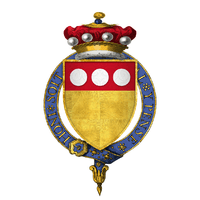Thomas de Camoys, 1st Baron Camoys

Thomas de Camoys, 1st Baron Camoys of the second creation, KG (c. 1351 – 28 March 1421),[1] was an English peer who commanded the left wing of the English army at the Battle of Agincourt.
Thomas de Camoys was the grandson of Ralph de Camoys (d.1336) by his second wife, Elizabeth le Despenser, daughter of Hugh le Despenser, 1st Earl of Winchester (executed 27 October 1326),[2] and the son of Sir John Camoys of Gressenhall, Norfolk, by his second wife, Elizabeth le Latimer, daughter of William le Latimer, 3rd Lord Latimer.[3] From 20 August 1383 to 26 February 1421 he was summoned to Parliament by writ, by which he is held to have become 1st Baron Camoys of the second creation, the first creation of the barony having expired with the death on 11 April 1372 of his uncle, Thomas de Camoys, 2nd Baron Camoys, to whom he was heir.[4]
In 1380 Camoys was in the retinue of his cousin, William Latimer, 4th Baron Latimer in an expedition to France, and was knighted by Thomas of Woodstock, then Earl of Buckingham.[5] He also served in an expedition to Scotland in 1385.[6]
According to Leland, Camoys benefited little under Richard II, and after Richard's deposition attended Henry IV's first parliament. His loyalty to the new king brought him several grants. His son, Richard, was knighted by the king at his coronation, and he himself escorted Henry's new queen, Joan of Navarre, to England in June 1403.[7]
Prior to Henry V's embarkation for France, Camoys was present at a meeting of the King's council held for the purpose of planning the invasion, and was appointed on 31 July 1415 to the commission which condemned Richard, Earl of Cambridge and Henry Scrope, 3rd Baron Scrope of Masham, to death for the Southampton Plot. At the Battle of Agincourt, Camoys commanded the rearguard, on the left of the English line, and in recognition of his service was made a Knight of the Garter on 23 April 1416.[8]
Camoys married, firstly, Elizabeth Louches, daughter and heiress of William Louches of Great Milton and Chiselhampton, Oxfordshire.[9] By her he had a son, Sir Richard Camoys, who predeceased him,[10] and whose son, Hugh Camoys, inherited the barony, and a daughter, Alice Camoys, who married Sir Leonard Hastings (d. 20 October 1455) and had issue four sons, William Hastings, 1st Baron Hastings, Sir Richard, Sir Ralph, and Thomas, and three daughters, Elizabeth, who married Sir John Donne, Anne, who married Thomas Ferrers, and Joan, who married John Brokesby.[11] Lord Camoys married secondly, Elizabeth Mortimer, widow of Henry 'Hotspur' Percy, and daughter of Edmund Mortimer, 3rd Earl of March, and Philippa, 5th Countess of Ulster, daughter of Lionel of Antwerp, second son of King Edward III. By his second wife he had a son, Sir Roger Camoys.[12]
Camoys inherited the manors of Trotton, Broadwater and Elsted in Sussex, and several manors in Northamptonshire from his uncle, Thomas de Camoys, 2nd Baron Camoys (d.1372),[13] and Elizabeth Louches brought him the smaller of two manors at Chiselhampton, Oxfordshire. The fortified farm house of the latter manor is still known as Camoys Court.[14]
Camoys' second wife, Elizabeth Mortimer, died 20 April 1417.[15] Camoys himself died on 28 March 1421.[16] According to Leland, the date of his death is wrongly given as 28 March 1419 on the brass in St. George's Church, Trotton.[17] He was succeeded in the barony by his grandson, Hugh Camoys.
From a legal record in 1422, it would appear that he died intestate, with his estate being administered by Geoffrey Colet & William Estfeld [18]
Notes
- ↑ Richardson I 2011, pp. 398–9.
- ↑ Richardson II 2011, pp. 64–7.
- ↑ Richardson I 2011, pp. 394–8, 546.
- ↑ Cokayne 1912, p. 506; Leland 2004; Richardson I 2011, p. 398.
- ↑ Leland 2004; Tuck 2004.
- ↑ Leland 2004.
- ↑ Leland 2004.
- ↑ Leland 2004.
- ↑ Richardson I 2011, p. 398.
- ↑ Leland 2004.
- ↑ Richardson II 2011, p. 369.
- ↑ Cokayne 1912, p. 508; Richardson I 2011, pp. 398–9.
- ↑ Richardson I 2011, p. 398; Leland 2004.
- ↑ Lobel 1962, pp. 5–16
- ↑ Richardson I 2011, p. 399.
- ↑ Cokayne 1912, p. 508.
- ↑ Leland 2004.
- ↑ Plea Rolls of the Court of Common Pleas; National Archives; CP 40/647; http://aalt.law.uh.edu/AALT1/H6/CP40no647/bCP40no647dorses/IMG_0598.htm; 4th entry, with county margin Sussex, in a plea of debt against various people in Sussex.
References
- Cokayne, George Edward (1912). The Complete Peerage, edited by H.A. Doubleday. II. London: St. Catherine Press. pp. 506–10.
- Kidd, Charles; Williamson, David (1995). Camoys, Baron (Stonor). London: Debrett's Peerage Limited. p. 208.
- Leland, John L. (2004). "Camoys, Thomas, Baron Camoys (c.1350-1420/21)". Oxford Dictionary of National Biography (online ed.). Oxford University Press. doi:10.1093/ref:odnb/4461. (Subscription or UK public library membership required.)
- Lobel, Mary D., ed. (1962). A History of the County of Oxford: Volume 7: Thame and Dorchester Hundreds. pp. 5–16.
- Richardson, Douglas (2011). Everingham, Kimball G., ed. Magna Carta Ancestry: A Study in Colonial and Medieval Families. I (2nd ed.). Salt Lake City. ISBN 1449966373.
- Richardson, Douglas (2011). Everingham, Kimball G., ed. Magna Carta Ancestry: A Study in Colonial and Medieval Families. II (2nd ed.). Salt Lake City. ISBN 1449966381.
- Tuck, Anthony (2004). "Thomas, duke of Gloucester (1355-1397)". Oxford Dictionary of National Biography (online ed.). Oxford University Press. doi:10.1093/ref:odnb/4461. (Subscription or UK public library membership required.)
External links
| Peerage of England | ||
|---|---|---|
| Preceded by New Creation |
Baron Camoys 1383–1419/1421 |
Succeeded by Hugh de Camoys |